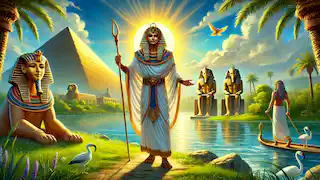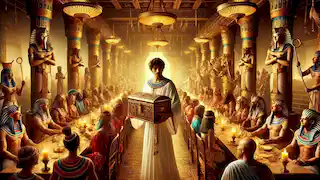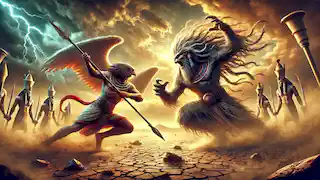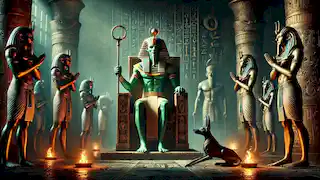The Story of Osiris
Reading time: 16 min

About this story: The Story of Osiris is a Myth from Egypt set in the Ancient This Dramatic tale explores themes of Good vs. Evil and is suitable for All Ages. It offers Cultural insights. A dramatic tale of love, betrayal, and the eternal cycle of life and death in ancient Egypt.
In the ancient, mystical land of Egypt, there existed a time before the rise of the Pharaohs and the construction of the colossal pyramids, when gods walked among mortals and the divine ruled the earth. Egypt was a fertile land, nurtured by the life-giving waters of the Nile, and the gods blessed it with wisdom, justice, and abundance. Chief among these divine beings was Osiris, a benevolent king and god who ruled Egypt with unmatched wisdom and fairness. His rule was the epitome of peace, prosperity, and harmony, bringing civilization and order to a land that had once been wild and untamed. But with every tale of greatness, shadows of envy, betrayal, and tragedy follow closely behind. The story of Osiris is one such tale—a story of love and loss, betrayal and revenge, death and resurrection, and the eternal struggle between order and chaos.
Osiris was not merely a king among men, but a god of immense power and significance. He was the son of Nut, the sky goddess, and Geb, the earth god. From his divine birth, Osiris was destined to bring order to the world, to establish justice and law, and to ensure that the people of Egypt could thrive under his rule. His reign brought with it the flourishing of civilization; the people learned to cultivate the land, to grow crops, and to harness the bounties of the Nile. Under Osiris, Egypt became the center of learning, culture, and spirituality, a beacon of light in the ancient world.
Beside Osiris stood his beloved wife and queen, Isis. She was as wise and powerful as she was beautiful, a goddess of magic and fertility who complemented Osiris in every way. Together, they were the embodiment of divine balance—Osiris, the king who brought life and order to the world, and Isis, the queen who nurtured and protected that life. Their love was legendary, a bond that transcended the earthly realm and echoed throughout the cosmos.
However, lurking in the shadows of Osiris' greatness was his brother, Seth, the god of chaos, violence, and the desert. Seth was the embodiment of disorder, and he loathed everything that Osiris represented. While Osiris brought fertility and civilization, Seth thrived in the barren wastelands and in the destructive forces of nature. Seth's jealousy of his brother grew with each passing year, and his envy soon turned to hatred. He could not bear to see Egypt flourish under Osiris' rule, nor could he tolerate being overshadowed by his brother's success and the people's love for him.
As Seth's resentment festered, he began to devise a plan to overthrow Osiris and take the throne for himself. Seth's mind was as cunning as it was dark, and he knew that if he wanted to succeed, he would need to be patient and meticulous in his plotting. He waited for the right moment, gathering his loyal followers and preparing his treacherous scheme. When the time was ripe, Seth set his plan in motion.
The Golden Age of Osiris
Before Seth's betrayal, Egypt had experienced a golden age under the rule of Osiris and Isis. Osiris, in his wisdom, had taught the people the secrets of agriculture, showing them how to cultivate the fertile lands along the Nile. Under his guidance, the people of Egypt learned to sow seeds, tend to their crops, and harvest their bountiful yields. Osiris introduced them to the art of winemaking and brewing beer, providing the people with sustenance and joy. He also established laws and governance, ensuring that justice was upheld and that peace reigned throughout the land.
The people of Egypt adored Osiris, for he was not a distant or vengeful god but one who walked among them, guiding them with kindness and fairness. Temples were erected in his honor, and festivals were held to celebrate the blessings he had bestowed upon the land. Egypt thrived under his rule, becoming a land of abundance, culture, and learning. The Nile flooded each year, bringing life-giving silt to the farmlands, and the people worshipped Osiris as the god who brought them this bounty.
Beside him, Isis was worshipped as the goddess of fertility, motherhood, and magic. She was revered not only for her beauty but for her wisdom and her power. It was said that Isis' magic was unmatched, that she knew the secret names of the gods, and that her knowledge of the divine mysteries allowed her to perform feats of wonder and awe. She was the protector of the weak, the nurturer of the living, and the guide to the dead. Together, Osiris and Isis ruled Egypt with love and compassion, their reign a shining example of harmony and prosperity.
Yet, as the people of Egypt flourished, Seth's heart grew darker. He watched with envy as Osiris and Isis were worshipped, and as the land thrived under their rule. In the desolate deserts, Seth brooded over his perceived injustices. He believed that he, too, deserved the throne, that he was being unfairly denied the power and respect that should have been his. His bitterness turned to rage, and in that rage, he conceived a plot so devious that it would change the fate of Egypt forever.
The Treacherous Plot of Seth
Seth knew that if he were to seize the throne, he would have to eliminate Osiris. However, he also knew that Osiris was beloved by the gods and the people alike, and that a direct assault would likely lead to his own downfall. Instead, Seth decided to employ cunning and deceit, knowing that betrayal from within would be far more effective than a battle from without.
To this end, Seth organized a grand feast, inviting Osiris, Isis, and all the gods of Egypt to attend. The feast was a lavish affair, filled with music, dance, and the finest foods and drinks that Egypt had to offer. Seth made sure that everything was perfect, ensuring that no one suspected his true intentions. Osiris, ever trusting, accepted the invitation, unaware that his own brother was plotting his demise.
During the feast, Seth unveiled a magnificent chest—crafted of cedar wood and adorned with gold, ivory, and precious gems. It was a work of art, and it immediately caught the attention of all who saw it. Seth, pretending to be generous and playful, announced that he would give the chest to anyone who could fit perfectly inside it.
Intrigued, the gods took turns trying to fit into the chest, but none were successful. The chest had been carefully crafted to fit only one person—Osiris. When it was Osiris' turn, Seth urged him to try. Osiris, having no reason to doubt his brother, lay down in the chest. As soon as Osiris was inside, Seth's true plan was revealed. With the help of his followers, Seth slammed the lid shut and sealed it tight with molten lead, trapping Osiris inside.
Osiris, the great king of Egypt, was now a prisoner within the chest, unable to escape. Seth and his accomplices quickly carried the chest to the Nile and cast it into the river. The current carried the chest away, and with it, Osiris disappeared from the world of the living.
With Osiris gone, Seth seized the throne and declared himself king of Egypt. But Seth's reign was not one of peace and prosperity. Instead, chaos descended upon the land. The Nile ceased to flood, crops withered and died, and famine spread across Egypt. The people, once joyful under Osiris' rule, now suffered under Seth's tyranny. But despite Seth's apparent victory, the story of Osiris was far from over.

Isis' Search for Osiris
The news of Osiris' disappearance reached Isis, and her heart was filled with grief. She could not accept that her beloved husband was gone, and she vowed to find him, no matter the cost. Driven by her love for Osiris and her determination to restore him to his rightful place, Isis set out on a long and perilous journey across Egypt in search of the chest that held Osiris' body.
Isis' search took her to the farthest reaches of the land. She traveled through scorching deserts, over treacherous mountains, and along the banks of the Nile, all the while using her magic and wisdom to guide her. She called upon the spirits of the land, the creatures of the earth and sky, to aid her in her quest. But despite her efforts, Osiris remained lost, and Isis' hope began to wane.
It was during this time of despair that Isis received a message from the gods, guiding her to the distant land of Byblos. There, she learned that the chest containing Osiris' body had washed ashore and had been taken into the palace of the king of Byblos. The chest had become part of a great pillar that supported the roof of the palace, and it seemed as though it was forever out of her reach.
But Isis was not one to be easily deterred. She disguised herself as a humble nursemaid and entered the palace, where she befriended the queen of Byblos. Her gentle nature and her skill with magic quickly earned her the queen's trust, and soon, the queen confided in her the secret of the chest. Moved by Isis' story of love and loss, the queen allowed her to retrieve the chest from within the pillar.
With great care, Isis took the chest and returned to Egypt. She opened it, and there, lying lifeless, was the body of Osiris. Though her heart was heavy with grief, Isis knew that her journey was not yet over. She believed that with her magic, she could bring Osiris back to life.
The Resurrection of Osiris
Isis, with the help of her sister Nephthys and the jackal-headed god Anub
is, performed the ancient and sacred rituals required to restore Osiris to life. They carefully wrapped his body in linen bandages, preparing him for his journey into the afterlife. Isis used her magic to breathe life back into Osiris, calling upon the powers of the gods and the forces of the universe to aid her in her task.
After many days of ritual and incantation, Osiris stirred. Though he had been dead, he was not truly lost. Isis had succeeded in bringing him back, but the resurrection was incomplete. Osiris could not return to the world of the living in his former state. Instead, he was transformed into the god of the underworld, ruler of the Duat, the realm of the dead.
Despite his resurrection, Osiris could not remain among the living. His role was now to preside over the dead, to judge the souls of those who had passed from the mortal realm. He would weigh their hearts against the feather of Ma'at, the goddess of truth and justice. Those whose hearts were pure would be allowed to pass into the afterlife, where they would dwell in peace for all eternity. Those whose hearts were weighed down by sin would be devoured by Ammit, the soul-eating monster, and their existence would end.
Isis mourned for Osiris, but she took solace in the knowledge that he would continue to serve a vital role in the universe. His death had not been in vain, and his new position as lord of the underworld ensured that justice and balance would be maintained in both the world of the living and the world of the dead.
The Birth of Horus and the Struggle for Egypt
Though Osiris could no longer rule the living, the legacy of his reign would continue. Shortly after Osiris' resurrection, Isis gave birth to their son, Horus. Horus was destined to avenge his father's death and reclaim the throne of Egypt from Seth. He was born a god of kingship and the sky, his head bearing the visage of a falcon, symbolizing his connection to the heavens and his divine right to rule.
Isis, knowing the danger that Horus faced, hid him away in the marshes of the Nile Delta, far from Seth's reach. There, she raised him in secret, teaching him the ways of magic, wisdom, and combat. Horus grew strong under his mother's care, and as he came of age, he knew that the time had come to confront his uncle and restore his father's legacy.
The battle between Horus and Seth was long and brutal, a struggle that shook the very foundations of the earth and sky. Horus, the god of order and rightful kingship, clashed with Seth, the god of chaos and destruction. The two forces were evenly matched, and their battles raged across the deserts, the mountains, and the Nile itself. Neither could gain the upper hand, and for years, the war between them continued.
During one of their many battles, Seth struck a grievous blow to Horus, gouging out one of his eyes. This eye, the Eye of Horus, became a powerful symbol in Egyptian mythology, representing healing, protection, and the restoration of order. Despite the injury, Horus was able to recover, with the help of the god Thoth, who used his wisdom and magic to restore Horus' eye.
The gods themselves watched the conflict between Horus and Seth, and eventually, they decided that the time had come to intervene. They called a divine tribunal, where both Horus and Seth presented their claims to the throne of Egypt. After much deliberation, the gods ruled in favor of Horus, declaring him the rightful heir to the throne. Seth was defeated and banished to the desert, where his chaotic influence would be confined to the barren wastelands.
With Seth's defeat, Horus ascended to the throne of Egypt, restoring order and balance to the land. The people rejoiced, for under Horus' rule, the land once again flourished. The Nile resumed its flooding, the crops grew strong, and the people thrived as they had under Osiris.

Osiris, Lord of the Underworld
Though Osiris had been avenged, his destiny remained tied to the underworld. As the ruler of the Duat, Osiris presided over the dead, ensuring that the souls of the deceased were judged fairly and that justice was maintained in the afterlife. His role was to weigh the hearts of the dead against the feather of Ma'at, determining whether they had lived virtuous lives.
Osiris' position as lord of the underworld made him one of the most important gods in the Egyptian pantheon. His story of death and resurrection became a central theme in Egyptian religion, symbolizing the eternal cycle of life, death, and rebirth. Osiris' journey from life to death and back again mirrored the natural cycles of the world, particularly the annual flooding of the Nile, which brought life to the land each year.
The people of Egypt worshipped Osiris as the god who ensured the continued existence of the afterlife. His story gave them hope that death was not the end, but merely a transition to a new phase of existence. They believed that if they lived according to the principles of Ma'at—truth, justice, and balance—they would be judged favorably by Osiris and would be granted eternal life in the afterlife.
Temples were built in honor of Osiris, and rituals were performed to ensure the safe passage of souls into the afterlife. The priests of Osiris played a vital role in Egyptian society, acting as intermediaries between the living and the dead, performing funerary rites, and preserving the stories of Osiris' resurrection.

The Legacy of Osiris
The story of Osiris left an indelible mark on Egyptian religion and culture, influencing their beliefs about life, death, and the afterlife for thousands of years. The myth of Osiris, Isis, and Horus became a cornerstone of Egyptian spirituality, and their divine family was worshipped throughout the land.
One of the most important rituals associated with Osiris was the Festival of Osiris, which took place every year during the flooding of the Nile. This festival was a time of mourning and celebration, as the people reenacted the death and resurrection of Osiris. They would mourn his death and entombment, symbolizing the death of the crops during the dry season, and then celebrate his resurrection, representing the renewal of life brought by the Nile's floodwaters.
The pharaohs of Egypt, who were considered living gods, identified themselves with Horus during their lifetimes and with Osiris in death. Upon their deaths, the pharaohs believed that they would become one with Osiris, taking their place as rulers of the afterlife. Their successors would then take on the mantle of Horus, continuing the divine cycle of kingship and renewal.
The story of Osiris also had a profound impact on Egyptian art and architecture. His temples were decorated with scenes of his death, resurrection, and judgment of the dead, and his image was often depicted in tombs to ensure the safe passage of the deceased into the afterlife. The symbol of the Eye of Horus became one of the most recognizable and powerful symbols in Egyptian culture, representing protection, healing, and the triumph of order over chaos.
In time, the story of Osiris spread beyond the borders of Egypt, influencing the religious beliefs of other cultures in the ancient world. His tale of resurrection and eternal life resonated with people across the Mediterranean, and elements of his myth can be found in the religious practices of the Greeks, Romans, and other ancient civilizations.
Conclusion
The story of Osiris is a tale of cosmic significance, one that touches on the deepest mysteries of life, death, and the afterlife. It is a story of love that transcends death, of justice that prevails over chaos, and of the eternal cycles of nature that govern the world. Osiris, once a living king, became a symbol of resurrection and the afterlife, giving hope to the people of Egypt that death was not the end but a new beginning.
Osiris' journey from life to death, and back to life again, reflects the eternal cycles of the earth, the rhythms of the Nile, and the endless dance of creation and destruction. His legacy endures in the temples, the myths, and the hearts of those who seek to understand the mysteries of existence.
Through the ages, the story of Osiris has remained a powerful reminder that even in the face of death, there is always the possibility of renewal and rebirth. His tale, woven into the fabric of Egyptian religion and culture, continues to inspire those who seek wisdom, justice, and hope.


















